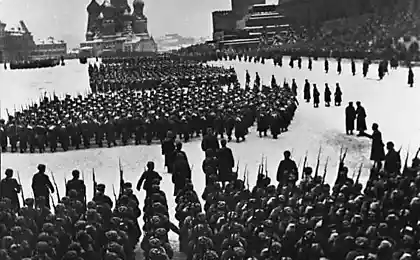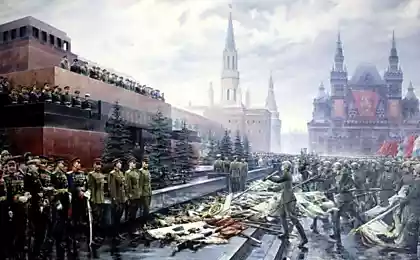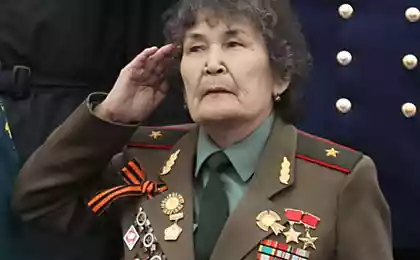1166
What equipment will be on parade on Red Square?
GAZ-2330 "Tiger" - the Russian multi-purpose road vehicle, armored, army vehicle SUV. Produced GAZ Group (OJSC "GAZ", Russia) at the Gorky Automobile and Arzamas Machinery Plant, with YaMZ-5347-10 (Russia), Cummins B-205. Some of the earliest examples were equipped with engines GAZ-562 (license Steyr), Cummins B-180 and B-215.
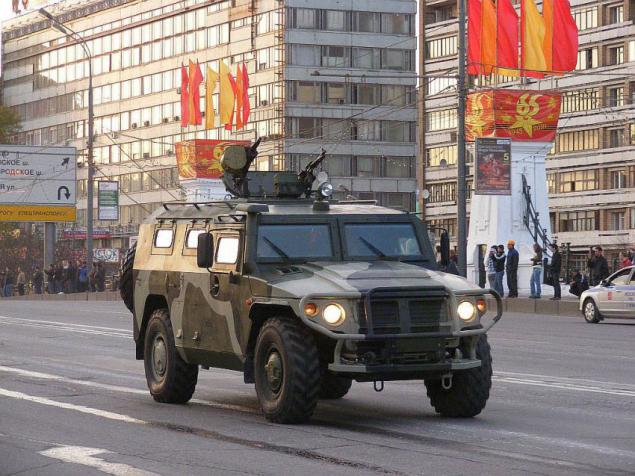
BTR-80 - Soviet armored personnel carrier. Created in the early 1980s as the further development of the armored personnel carrier BTR-70, taking into account the identified deficiencies in the Afghan war of the latter, and was intended to replace it in a mechanized infantry troops. BTR-80 went into production in 1984, and repeatedly modernized, and as of 2012 is still in production. Last modification BTR-80, equipped with enhanced weapons, many experts are classified as wheeled infantry fighting vehicles. It was used by Soviet troops in the Afghan war, and since the 1990s, is the main armored vehicles of the Armed Forces of Russia and other former Soviet republics and has been used in virtually every major armed conflicts in the former Soviet Union. Actively supplied and exported, in total, as of the 2011 BTR-80 is in service with approximately 26 states.
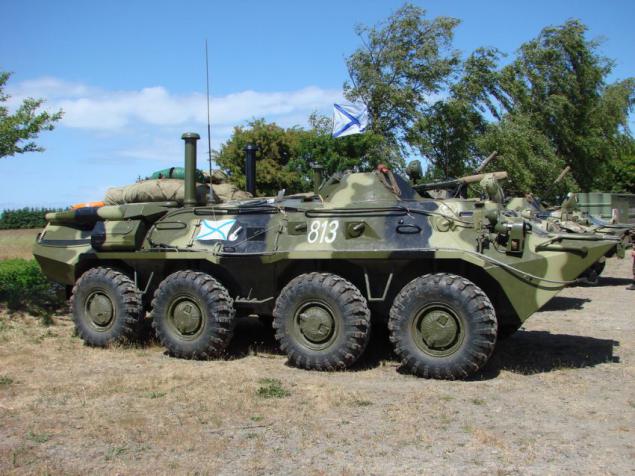
BTR-82A - version with engine capacity of 300 liters. a., with the set of 14, 5-mm machine gun KPVT (BTR-82), or high-velocity 30 mm cannon 2A72 (BTR-82A) coupled with 7 62-mm machine gun PKTM, electric and digital two-scene stabilizer arms, combined vsesutochnym gunner's sight TKN-4ga stabilized field of view and remote control channel snaryada.Povyshena undermine the vitality, continuity, reliability and resource exploitation. Installed as antioskolochnaya protection and air conditioning. According to experts, the coefficient of the combat effectiveness of the BTR-82 and BTR-82A has doubled compared to the BTR-80 and BTR-80A, respectively [19]. Prototypes of the BTR-82 and BTR-82A were collected in December 2009 at the Arzamas Machine Building Plant (AMZ). Test cars have been in the winter of 2010, after which they were adopted. In 2011, BTR-82A were rearmed some parts of the Southern Military District. Until 2013 scheduled delivery of 100 BTR-82 to Kazakhstan. After successful trials of the BTR-82 adopted by the Republic of Armenia in 2013 by order of the Minister of Defense Sergei Shoigu
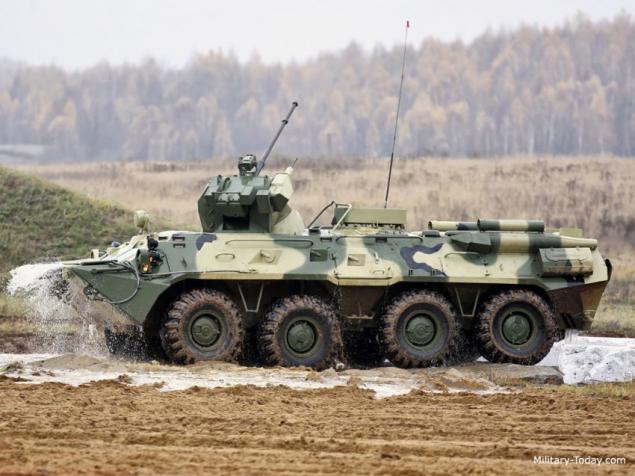
T-90 "Vladimir" - a Russian main battle tank.
Created in the late 1980s - early 1990s as the modernization of T-72B tank under the name "T-72B advanced", but in 1992 was adopted already under the T-90. After the death of Vladimir Ivanovich Potkina, chief designer of the tank, the decision of the Government of the Russian Federation T-90 was named "Vladimir».
T-90A, an upgraded version of the T-90 (the original "object 188A1") go into production in 2004 has several important being improved:
as a night sight mounted thermal imager "Buran-M" on the modification of 2004, subsequently modified in 2006 began to establish a modern thermal imager second generation "PAS" matrix «Catherine FC», stabilized in two planes, integrated with the main gun and distance measuring channel, which increased night vision range from 1,800 to 4,000 m;
former cast turret replaced by a reinforced frontal envelope with welded parts up to 950 mm, which significantly increased its resistance BOPS / COP;
instead of the 840-hp engine installed in 1000-strong diesel V-92S2. There was a possibility of installation of the tank on the 1200-strong diesel engine B-99;
replaced stabilizer guns, double the increase the speed and improve the targeting accuracy with stroke.

"Buk" (classified DoD and NATO - SA-11 Gadfly) and its modifications "Buk-M1" - a self-propelled anti-aircraft missile system designed to combat maneuvering aerodynamic targets at low and medium altitudes (from 30 m to 14 18 km) in heavy jamming.

"Triumph" (S-400, on the classification of the US DoD and NATO - SA-21 Growler, literally "Grumpy") - Russia's anti-missile system is a large and medium-range air defense missile system (SAM) of the new generation. It is intended for the destruction of all current and future air and space attack - aircraft reconnaissance aircraft of strategic (including aircraft invisible) and tactical aircraft, tactical, operational-tactical ballistic missiles, medium range ballistic missiles, hypersonic targets, jammers , aircraft radar surveillance and guidance systems and other. Each AAMS provides simultaneous firing of up to 36 targets with guided them to 72 missiles.
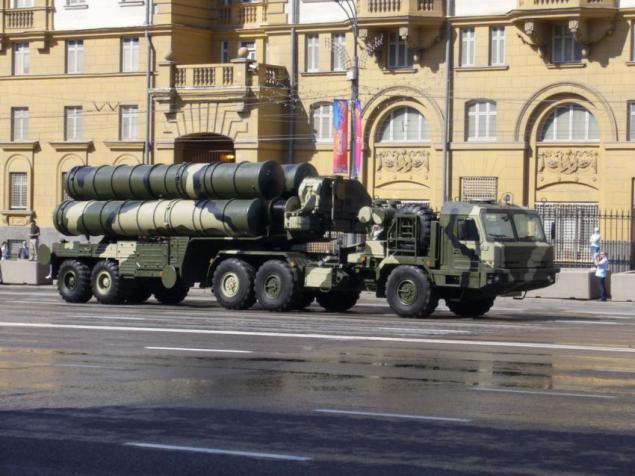
Pantsir-S1 (NATO - SA-22 Greyhound (Eng. Greyhound)) - the Russian self-propelled anti-aircraft missile-gun system (ZRPK) land-based.
Designed Tula State Unitary Enterprise "Instrument Design Bureau". Designed for short-range covering civil and military facilities (including long-range air defense systems) from all current and future air threats. It may also carry out protection defended object from ground and surface threats.

"Iskander" (classified DoD and NATO - SS-26 Stone, English. Stone) - a family of tactical missile systems (PTRC): Iskander Iskander-E, Iskander-K. The complex is designed in the Kolomna Machine-Building Design Bureau (KBM).
Designed to defeat warheads with conventional warheads of small and area targets in the depth of operational formation of enemy troops. It is assumed that there may be a means of delivery of tactical nuclear weapons.
The most likely target:
fire weapons (missiles, multiple launch rocket systems, long-range artillery)
and missile defense
airplanes and helicopters on the ground
command posts and communications centers
essential civilian infrastructure
Martial characteristics
The circular error probable: 10-30 m (depending on the applicable guidance system)
Missile launch weight: 3800 kg
Warhead weight: 480 kg
Length 7 m 2
Diameter 920 mm
The speed of the rocket after the initial part of the trajectory: 2100 m / c = 7560 km / h = 6, 9 M
The minimum distance of defeats the purpose of: 50 km
The maximum range of the target lesion:
500 km of the Iskander-K
280 km of the Iskander-E
Time to launch the first missile: 4-16 minutes
The interval between scans: 1 minute (for launcher with two missiles 9P78)
Operating temperature range: from -50 ° C to 50 ° C
The service life of 10 years, including 3, in the field
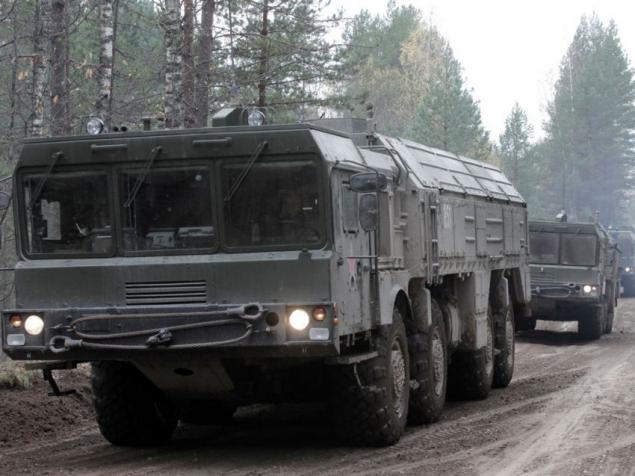
RT-2PM2 "Topol-M" (on the classification of the US DoD and NATO - SS-27 Sickle B, Eng. Hammer)) - Russia's strategic missile systems, developed in the late 1980s - early 1990s on the basis of a complex of Tatarstan -2PM "Topol". The first ICBM, developed in Russia after the Soviet collapse.
Number of stages 3
Length (with MS) 22, 55 m
Length (without MS) 17, 5 m
The diameter of 1, 81 m
Launch weight 46, 5 tons
Throw-weight of 1, 2 tons
Fuel firm the blending
The maximum range of 11,000 km
Type monoblock warhead, nuclear, detachable
The number of warheads 1 (+ ~ 20 decoys)
Power charge 0, 55 Mt
Autonomous management system, inertial-based ODCC
Method-based mining and mobile
Rocket 15ZH65 three-stage, solid-fuel. Limiting the range of - 11 000 km. It carries a thermonuclear warhead capacity of 550 kt.
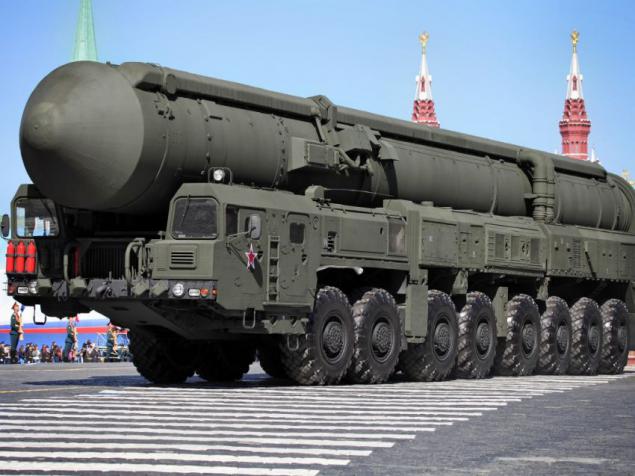
"Thor" (classified DoD and NATO - SA-15 Gauntlet («gauntlet")) - an all-weather tactical air defense missile system, designed to meet the challenges and missile defense at the divisional level.
The system of "Thor" is intended to cover the important administrative, economic, and military installations, the first tier of connections from ground strikes antiradar missiles and cruise missiles, remotely piloted aircraft planning to bombs, airplanes and helicopters, including those made by technology "stealth". It can work both in manual, with the participation of operators and fully automatic mode. The system of "Thor" she controls the airspace designation and self knocks down all air targets are not recognized by the system "friend or foe».
"Thor-m2K" - anti-aircraft missile system with fighting machine on a wheeled chassis. The chassis is designed to Belarusian enterprise "MZKT." The structure of the complex combat equipment includes: combat vehicles and air defense missile unit with four surface-to-air missile.
TTX
The affected area:
in range from 1 to 15 kilometers
height: from 0, 01 to 10 km
parameter for the course: 8 km
The reaction time, with 4, 8
Max. the speed of the targeted objectives of 700 m / s
Number of simultaneously engaged targets 4
Maximum Overload rocket 30 g
Airspeed SAM 700..800 m / s
The minimum target RCS 0, 05 m² [18]
Jamming radio command guidance system
Number of targeted channels 4 channels
The number of missiles on combat vehicle 8 missiles
Year of development 2008
Crew 3 people
Cruising 500 km

KAMAZ-63968 "Typhoon" - versatile armored car increased the vulnerability of the original chassis. Corresponding vehicle type MRAP. It is part of a family of armored vehicles "Typhoon". Armored cars was created after the approval of the Concept of development of military vehicles of the Armed Forces of the Russian Federation for the period up to 2020, which is planned to manufacture vehicles based on standardized semeystv.KAMAZ-63968 "Typhoon" is part of a new stage in the development of domestic vehicles for the armed forces, as last car platform was adopted in 1961.
Axle configuration: 6 × 6
Length mm: 8990
Width 2550
Height mm
Cab: 3120
the fuselage 3300
Base, mm n /
Ground clearance, mm: adjustable
Turning radius, m: at least 10, 0
The angle of ascent: 23-30 °
Turning angle: 39 °
Curb weight of the car, that is 21, 0
Gross weight, t: 24, 0
Trailer weight, t: n / a
The maximum speed, km / h 105 km / h
Fuel distance, km: 1200
Fuel consumption per 100 km: no more than 35 liters
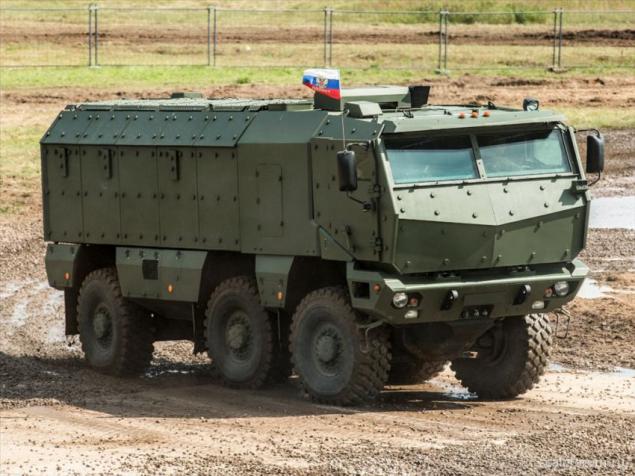
Chrysanthemum (NATO and the US Department of Defense - AT-15 Springer) - a self-propelled anti-tank missile system.
It was developed in the Kolomna Machine-Building Design Bureau. It is intended for destruction of tanks (including those equipped with reactive armor), BMP and other lightly armored targets, engineering and fortifications, surface targets, low-speed air targets and manpower (including shelters and outdoor areas).
The complex has a combined management system missiles:
Automatic radar in the millimeter range with guided missiles in antenna beam;
semi-guided missiles in the laser beam
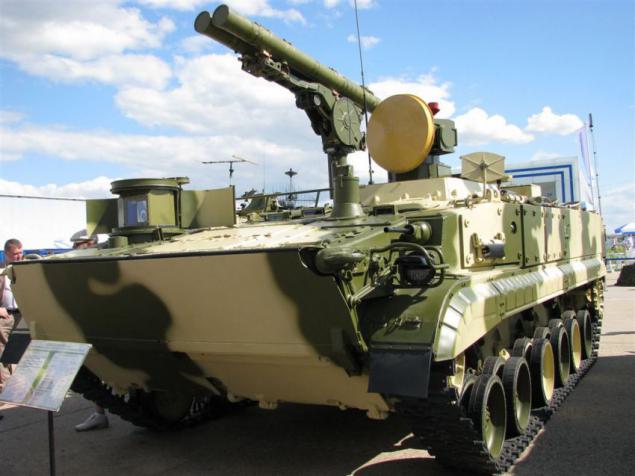
2S19 "MSTA-S" (NATO - M1990 «Farm») - modern Russian 152-mm self-propelled howitzer divisional. Developed at the Ural Plant of Transport Engineering. The chief designer of the ACS - Yu Tomashov, 152-mm gun 2A64 - GI Sergeev. SAU 2C19 is designed for destruction of tactical nuclear weapons, artillery and mortar batteries, tanks and other armored vehicles, anti-tank weapons, manpower, air defense and missile defense, command and control, as well as to destroy field fortifications and obstruction maneuvers of enemy reserves in the depth of his defense . Can fire on observable and unobservable targets from concealed positions, and direct fire, including work in the mountains. When used as a firing shots from boeukladki and served with soil. In 1989, a new self-propelled howitzer 2S19 "MSTA-S" was adopted by the artillery regiments of mechanized infantry and armored divisions of the Soviet army. For the first time on display at the air show in Zhukovsky in August 1992.

Further aircraft.
Su-24 (NATO: Fencer - «Swordsman") - Soviet / Russian bomber with variable sweep wing for applying air strikes in simple and adverse weather conditions, day and night, including at low altitudes with impact destroy ground and surface targets.
As of 2011 the average age of the Su-24, the armament of the Russian Air Force, was 25-27 let.Pervonachalno planned to replace 60-70% of the airplane fleet of Su-24, Su-34 is the newest, and the rest - to upgrade to the version of the Su-24M2. However, after a series of accidents, it was decided to write off all of the Su-24 in 2020 godu.Takzhe in February 2012 announced the withdrawal of the Su-24 bombers with Armament Republic of Belarus.
Su-24M - a modernized bomber made its first flight in 1976. Installed a new sighting and navigation system PNS-24M "Tiger". Capable of automatic and semi-automatic mode of flying with terrain following at an altitude of 50 770 pcs
m.Vypuscheno
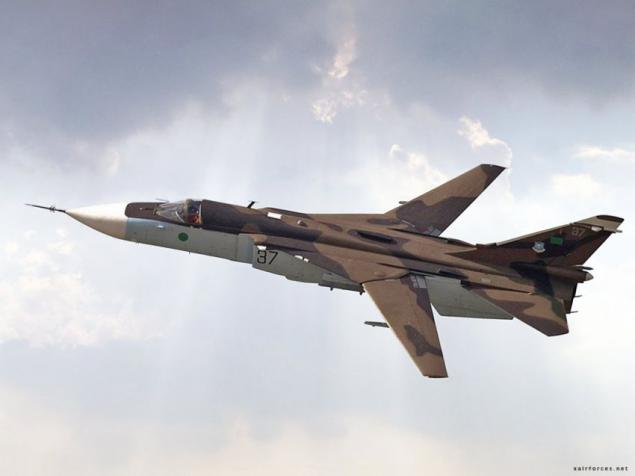
Su-34 (NATO designation for: Fullback - «Defender") - Russia's tactical fighter-bomber, as well positioned as a bomber.
Created on the basis of the Su-27. Applications include precision strikes, including the use of nuclear weapons by land and sea targets at any time.

Su-25 (NATO: Frogfoot) - Soviet / Russian armored subsonic attack aircraft designed for close support of ground forces on the battlefield, day and night with the line of sight goals, as well as the destruction of objects with the specified coordinates around the clock in any weather. The Russian and Ukrainian troops was nicknamed "Grach».

Su-27 (NATO: Flanker) - Soviet / Russian multipurpose all-weather fighter vysokomanёvrenny fourth generation, developed by the Sukhoi Design Bureau and is designed for air superiority.
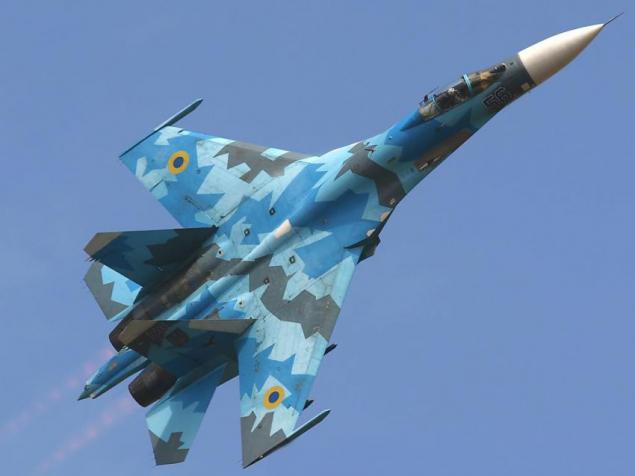
MiG-29 (9-12 product on NATO codification: Fulcrum - the fulcrum) - Soviet / Russian multipurpose fighter fourth generation, developed by the Mikoyan design bureau.
The plane is made by the integrated aerodynamic configuration, low-wing, two-keel plumage and spaced engines. The glider is made primarily of aluminum alloys and steel, titanium, and also applies the composite materials. Sweep angle of the wing leading edge was 42 deg., On the wing are slotted flaps, ailerons and flap. Keely have carbon-fiber trim and appearance "collapse" of 6 degrees. All-moving stabilizer and differential trends. Chassis tricycle, with two-wheeled odnokolёsnymi basic and pillar.

MiG-31 (NATO: Foxhound - fox hound) - Double supersonic all-weather fighter-interceptor long range. It developed in the 70s of XX century. The first Soviet combat aircraft of the fourth generation.
The MiG-31 is designed to intercept and destroy airborne targets at extremely low, low, medium and high altitudes, day and night, and adverse weather conditions, the application of active and passive enemy radar interference and false thermal purposes. A group of four MiG-31 is capable of controlling the air space at the front length of 800-900 km. Originally intended to intercept cruise missiles over the entire range of altitudes and speeds, as well as low-flying satellites. Squadrons of MiG-31, a number of years, had the status of special forces (Spetsnaz) as part of the air defense.
Practical range:
at a height of 10,000 m, when M = 0, 8: 1450 km
without refueling with two drop tanks: 3,000 km
with one refueling: up to 5400 km
Combat radius of 720 km
Flight duration: 3, 3 hours
Service ceiling: 20600 m
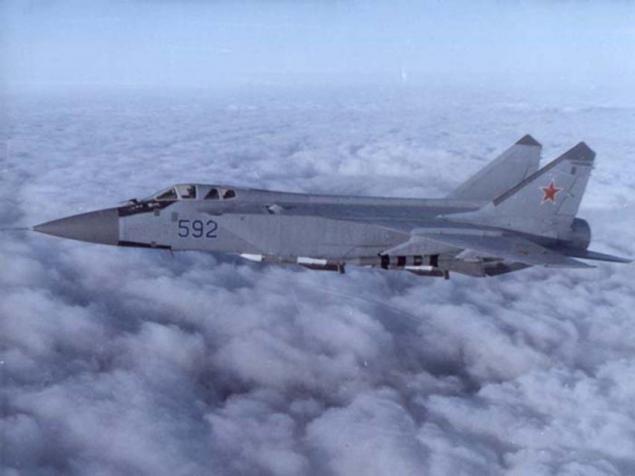
AN-22 "Antaeus" (NATO: Cock) - Soviet heavy turboprop transport aircraft. The first Soviet wide-body aircraft. The first flight was carried out in 1965. Commercially produced 68 copies, including two for the strength test.
Crew: 5-7 people
Passenger capacity: 28 people accompanying the goods, or 290 or 202 wounded soldiers or 150 paratroopers
Capacity: 60 000 kg
Length: 57, 31 m
Wingspan: 64 to 40 m
Height: 12 54 m
Wing area: 345 m²
Empty weight: 727 kg
118 Curb weight: 120 000 kg
Normal takeoff weight of 205 000 kg
Maximum takeoff weight: 225,000 kg
The weight of fuel in internal tanks of 96 000 kg
Engine power: 4 × 15 265 (4 × 11 240)
Screw diameter: 6, 20 m
Maximum speed: 650 km / h
Cruising speed: 560 km / h
Practical range: 5225 km
Ferry range: 8,500 km
Service ceiling: 9000 m
Takeoff run 1460 m
The path length: 800-1040 m
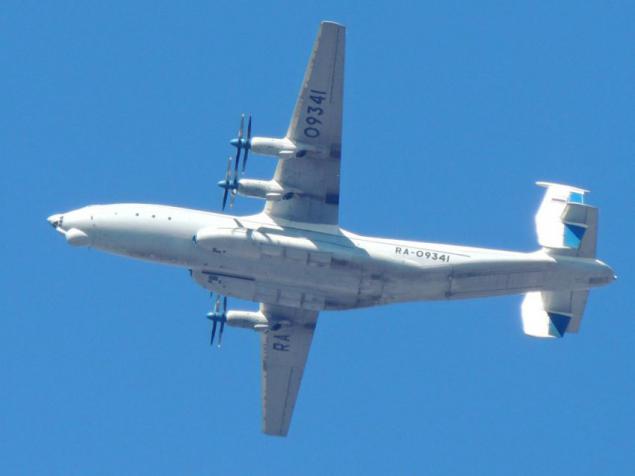
AN-124 "Ruslan" (NATO: Condor - «condor") - long-range heavy transport aircraft development OKB. Antonov.
Crew: 8 (commander, assistant commander, navigator, v. The flight engineer, flight engineer at JSC, radio operator, two operators of loading and unloading)

BTR-80 - Soviet armored personnel carrier. Created in the early 1980s as the further development of the armored personnel carrier BTR-70, taking into account the identified deficiencies in the Afghan war of the latter, and was intended to replace it in a mechanized infantry troops. BTR-80 went into production in 1984, and repeatedly modernized, and as of 2012 is still in production. Last modification BTR-80, equipped with enhanced weapons, many experts are classified as wheeled infantry fighting vehicles. It was used by Soviet troops in the Afghan war, and since the 1990s, is the main armored vehicles of the Armed Forces of Russia and other former Soviet republics and has been used in virtually every major armed conflicts in the former Soviet Union. Actively supplied and exported, in total, as of the 2011 BTR-80 is in service with approximately 26 states.

BTR-82A - version with engine capacity of 300 liters. a., with the set of 14, 5-mm machine gun KPVT (BTR-82), or high-velocity 30 mm cannon 2A72 (BTR-82A) coupled with 7 62-mm machine gun PKTM, electric and digital two-scene stabilizer arms, combined vsesutochnym gunner's sight TKN-4ga stabilized field of view and remote control channel snaryada.Povyshena undermine the vitality, continuity, reliability and resource exploitation. Installed as antioskolochnaya protection and air conditioning. According to experts, the coefficient of the combat effectiveness of the BTR-82 and BTR-82A has doubled compared to the BTR-80 and BTR-80A, respectively [19]. Prototypes of the BTR-82 and BTR-82A were collected in December 2009 at the Arzamas Machine Building Plant (AMZ). Test cars have been in the winter of 2010, after which they were adopted. In 2011, BTR-82A were rearmed some parts of the Southern Military District. Until 2013 scheduled delivery of 100 BTR-82 to Kazakhstan. After successful trials of the BTR-82 adopted by the Republic of Armenia in 2013 by order of the Minister of Defense Sergei Shoigu

T-90 "Vladimir" - a Russian main battle tank.
Created in the late 1980s - early 1990s as the modernization of T-72B tank under the name "T-72B advanced", but in 1992 was adopted already under the T-90. After the death of Vladimir Ivanovich Potkina, chief designer of the tank, the decision of the Government of the Russian Federation T-90 was named "Vladimir».
T-90A, an upgraded version of the T-90 (the original "object 188A1") go into production in 2004 has several important being improved:
as a night sight mounted thermal imager "Buran-M" on the modification of 2004, subsequently modified in 2006 began to establish a modern thermal imager second generation "PAS" matrix «Catherine FC», stabilized in two planes, integrated with the main gun and distance measuring channel, which increased night vision range from 1,800 to 4,000 m;
former cast turret replaced by a reinforced frontal envelope with welded parts up to 950 mm, which significantly increased its resistance BOPS / COP;
instead of the 840-hp engine installed in 1000-strong diesel V-92S2. There was a possibility of installation of the tank on the 1200-strong diesel engine B-99;
replaced stabilizer guns, double the increase the speed and improve the targeting accuracy with stroke.

"Buk" (classified DoD and NATO - SA-11 Gadfly) and its modifications "Buk-M1" - a self-propelled anti-aircraft missile system designed to combat maneuvering aerodynamic targets at low and medium altitudes (from 30 m to 14 18 km) in heavy jamming.

"Triumph" (S-400, on the classification of the US DoD and NATO - SA-21 Growler, literally "Grumpy") - Russia's anti-missile system is a large and medium-range air defense missile system (SAM) of the new generation. It is intended for the destruction of all current and future air and space attack - aircraft reconnaissance aircraft of strategic (including aircraft invisible) and tactical aircraft, tactical, operational-tactical ballistic missiles, medium range ballistic missiles, hypersonic targets, jammers , aircraft radar surveillance and guidance systems and other. Each AAMS provides simultaneous firing of up to 36 targets with guided them to 72 missiles.

Pantsir-S1 (NATO - SA-22 Greyhound (Eng. Greyhound)) - the Russian self-propelled anti-aircraft missile-gun system (ZRPK) land-based.
Designed Tula State Unitary Enterprise "Instrument Design Bureau". Designed for short-range covering civil and military facilities (including long-range air defense systems) from all current and future air threats. It may also carry out protection defended object from ground and surface threats.

"Iskander" (classified DoD and NATO - SS-26 Stone, English. Stone) - a family of tactical missile systems (PTRC): Iskander Iskander-E, Iskander-K. The complex is designed in the Kolomna Machine-Building Design Bureau (KBM).
Designed to defeat warheads with conventional warheads of small and area targets in the depth of operational formation of enemy troops. It is assumed that there may be a means of delivery of tactical nuclear weapons.
The most likely target:
fire weapons (missiles, multiple launch rocket systems, long-range artillery)
and missile defense
airplanes and helicopters on the ground
command posts and communications centers
essential civilian infrastructure
Martial characteristics
The circular error probable: 10-30 m (depending on the applicable guidance system)
Missile launch weight: 3800 kg
Warhead weight: 480 kg
Length 7 m 2
Diameter 920 mm
The speed of the rocket after the initial part of the trajectory: 2100 m / c = 7560 km / h = 6, 9 M
The minimum distance of defeats the purpose of: 50 km
The maximum range of the target lesion:
500 km of the Iskander-K
280 km of the Iskander-E
Time to launch the first missile: 4-16 minutes
The interval between scans: 1 minute (for launcher with two missiles 9P78)
Operating temperature range: from -50 ° C to 50 ° C
The service life of 10 years, including 3, in the field

RT-2PM2 "Topol-M" (on the classification of the US DoD and NATO - SS-27 Sickle B, Eng. Hammer)) - Russia's strategic missile systems, developed in the late 1980s - early 1990s on the basis of a complex of Tatarstan -2PM "Topol". The first ICBM, developed in Russia after the Soviet collapse.
Number of stages 3
Length (with MS) 22, 55 m
Length (without MS) 17, 5 m
The diameter of 1, 81 m
Launch weight 46, 5 tons
Throw-weight of 1, 2 tons
Fuel firm the blending
The maximum range of 11,000 km
Type monoblock warhead, nuclear, detachable
The number of warheads 1 (+ ~ 20 decoys)
Power charge 0, 55 Mt
Autonomous management system, inertial-based ODCC
Method-based mining and mobile
Rocket 15ZH65 three-stage, solid-fuel. Limiting the range of - 11 000 km. It carries a thermonuclear warhead capacity of 550 kt.

"Thor" (classified DoD and NATO - SA-15 Gauntlet («gauntlet")) - an all-weather tactical air defense missile system, designed to meet the challenges and missile defense at the divisional level.
The system of "Thor" is intended to cover the important administrative, economic, and military installations, the first tier of connections from ground strikes antiradar missiles and cruise missiles, remotely piloted aircraft planning to bombs, airplanes and helicopters, including those made by technology "stealth". It can work both in manual, with the participation of operators and fully automatic mode. The system of "Thor" she controls the airspace designation and self knocks down all air targets are not recognized by the system "friend or foe».
"Thor-m2K" - anti-aircraft missile system with fighting machine on a wheeled chassis. The chassis is designed to Belarusian enterprise "MZKT." The structure of the complex combat equipment includes: combat vehicles and air defense missile unit with four surface-to-air missile.
TTX
The affected area:
in range from 1 to 15 kilometers
height: from 0, 01 to 10 km
parameter for the course: 8 km
The reaction time, with 4, 8
Max. the speed of the targeted objectives of 700 m / s
Number of simultaneously engaged targets 4
Maximum Overload rocket 30 g
Airspeed SAM 700..800 m / s
The minimum target RCS 0, 05 m² [18]
Jamming radio command guidance system
Number of targeted channels 4 channels
The number of missiles on combat vehicle 8 missiles
Year of development 2008
Crew 3 people
Cruising 500 km

KAMAZ-63968 "Typhoon" - versatile armored car increased the vulnerability of the original chassis. Corresponding vehicle type MRAP. It is part of a family of armored vehicles "Typhoon". Armored cars was created after the approval of the Concept of development of military vehicles of the Armed Forces of the Russian Federation for the period up to 2020, which is planned to manufacture vehicles based on standardized semeystv.KAMAZ-63968 "Typhoon" is part of a new stage in the development of domestic vehicles for the armed forces, as last car platform was adopted in 1961.
Axle configuration: 6 × 6
Length mm: 8990
Width 2550
Height mm
Cab: 3120
the fuselage 3300
Base, mm n /
Ground clearance, mm: adjustable
Turning radius, m: at least 10, 0
The angle of ascent: 23-30 °
Turning angle: 39 °
Curb weight of the car, that is 21, 0
Gross weight, t: 24, 0
Trailer weight, t: n / a
The maximum speed, km / h 105 km / h
Fuel distance, km: 1200
Fuel consumption per 100 km: no more than 35 liters

Chrysanthemum (NATO and the US Department of Defense - AT-15 Springer) - a self-propelled anti-tank missile system.
It was developed in the Kolomna Machine-Building Design Bureau. It is intended for destruction of tanks (including those equipped with reactive armor), BMP and other lightly armored targets, engineering and fortifications, surface targets, low-speed air targets and manpower (including shelters and outdoor areas).
The complex has a combined management system missiles:
Automatic radar in the millimeter range with guided missiles in antenna beam;
semi-guided missiles in the laser beam

2S19 "MSTA-S" (NATO - M1990 «Farm») - modern Russian 152-mm self-propelled howitzer divisional. Developed at the Ural Plant of Transport Engineering. The chief designer of the ACS - Yu Tomashov, 152-mm gun 2A64 - GI Sergeev. SAU 2C19 is designed for destruction of tactical nuclear weapons, artillery and mortar batteries, tanks and other armored vehicles, anti-tank weapons, manpower, air defense and missile defense, command and control, as well as to destroy field fortifications and obstruction maneuvers of enemy reserves in the depth of his defense . Can fire on observable and unobservable targets from concealed positions, and direct fire, including work in the mountains. When used as a firing shots from boeukladki and served with soil. In 1989, a new self-propelled howitzer 2S19 "MSTA-S" was adopted by the artillery regiments of mechanized infantry and armored divisions of the Soviet army. For the first time on display at the air show in Zhukovsky in August 1992.

Further aircraft.
Su-24 (NATO: Fencer - «Swordsman") - Soviet / Russian bomber with variable sweep wing for applying air strikes in simple and adverse weather conditions, day and night, including at low altitudes with impact destroy ground and surface targets.
As of 2011 the average age of the Su-24, the armament of the Russian Air Force, was 25-27 let.Pervonachalno planned to replace 60-70% of the airplane fleet of Su-24, Su-34 is the newest, and the rest - to upgrade to the version of the Su-24M2. However, after a series of accidents, it was decided to write off all of the Su-24 in 2020 godu.Takzhe in February 2012 announced the withdrawal of the Su-24 bombers with Armament Republic of Belarus.
Su-24M - a modernized bomber made its first flight in 1976. Installed a new sighting and navigation system PNS-24M "Tiger". Capable of automatic and semi-automatic mode of flying with terrain following at an altitude of 50 770 pcs
m.Vypuscheno

Su-34 (NATO designation for: Fullback - «Defender") - Russia's tactical fighter-bomber, as well positioned as a bomber.
Created on the basis of the Su-27. Applications include precision strikes, including the use of nuclear weapons by land and sea targets at any time.

Su-25 (NATO: Frogfoot) - Soviet / Russian armored subsonic attack aircraft designed for close support of ground forces on the battlefield, day and night with the line of sight goals, as well as the destruction of objects with the specified coordinates around the clock in any weather. The Russian and Ukrainian troops was nicknamed "Grach».

Su-27 (NATO: Flanker) - Soviet / Russian multipurpose all-weather fighter vysokomanёvrenny fourth generation, developed by the Sukhoi Design Bureau and is designed for air superiority.

MiG-29 (9-12 product on NATO codification: Fulcrum - the fulcrum) - Soviet / Russian multipurpose fighter fourth generation, developed by the Mikoyan design bureau.
The plane is made by the integrated aerodynamic configuration, low-wing, two-keel plumage and spaced engines. The glider is made primarily of aluminum alloys and steel, titanium, and also applies the composite materials. Sweep angle of the wing leading edge was 42 deg., On the wing are slotted flaps, ailerons and flap. Keely have carbon-fiber trim and appearance "collapse" of 6 degrees. All-moving stabilizer and differential trends. Chassis tricycle, with two-wheeled odnokolёsnymi basic and pillar.

MiG-31 (NATO: Foxhound - fox hound) - Double supersonic all-weather fighter-interceptor long range. It developed in the 70s of XX century. The first Soviet combat aircraft of the fourth generation.
The MiG-31 is designed to intercept and destroy airborne targets at extremely low, low, medium and high altitudes, day and night, and adverse weather conditions, the application of active and passive enemy radar interference and false thermal purposes. A group of four MiG-31 is capable of controlling the air space at the front length of 800-900 km. Originally intended to intercept cruise missiles over the entire range of altitudes and speeds, as well as low-flying satellites. Squadrons of MiG-31, a number of years, had the status of special forces (Spetsnaz) as part of the air defense.
Practical range:
at a height of 10,000 m, when M = 0, 8: 1450 km
without refueling with two drop tanks: 3,000 km
with one refueling: up to 5400 km
Combat radius of 720 km
Flight duration: 3, 3 hours
Service ceiling: 20600 m

AN-22 "Antaeus" (NATO: Cock) - Soviet heavy turboprop transport aircraft. The first Soviet wide-body aircraft. The first flight was carried out in 1965. Commercially produced 68 copies, including two for the strength test.
Crew: 5-7 people
Passenger capacity: 28 people accompanying the goods, or 290 or 202 wounded soldiers or 150 paratroopers
Capacity: 60 000 kg
Length: 57, 31 m
Wingspan: 64 to 40 m
Height: 12 54 m
Wing area: 345 m²
Empty weight: 727 kg
118 Curb weight: 120 000 kg
Normal takeoff weight of 205 000 kg
Maximum takeoff weight: 225,000 kg
The weight of fuel in internal tanks of 96 000 kg
Engine power: 4 × 15 265 (4 × 11 240)
Screw diameter: 6, 20 m
Maximum speed: 650 km / h
Cruising speed: 560 km / h
Practical range: 5225 km
Ferry range: 8,500 km
Service ceiling: 9000 m
Takeoff run 1460 m
The path length: 800-1040 m

AN-124 "Ruslan" (NATO: Condor - «condor") - long-range heavy transport aircraft development OKB. Antonov.
Crew: 8 (commander, assistant commander, navigator, v. The flight engineer, flight engineer at JSC, radio operator, two operators of loading and unloading)

